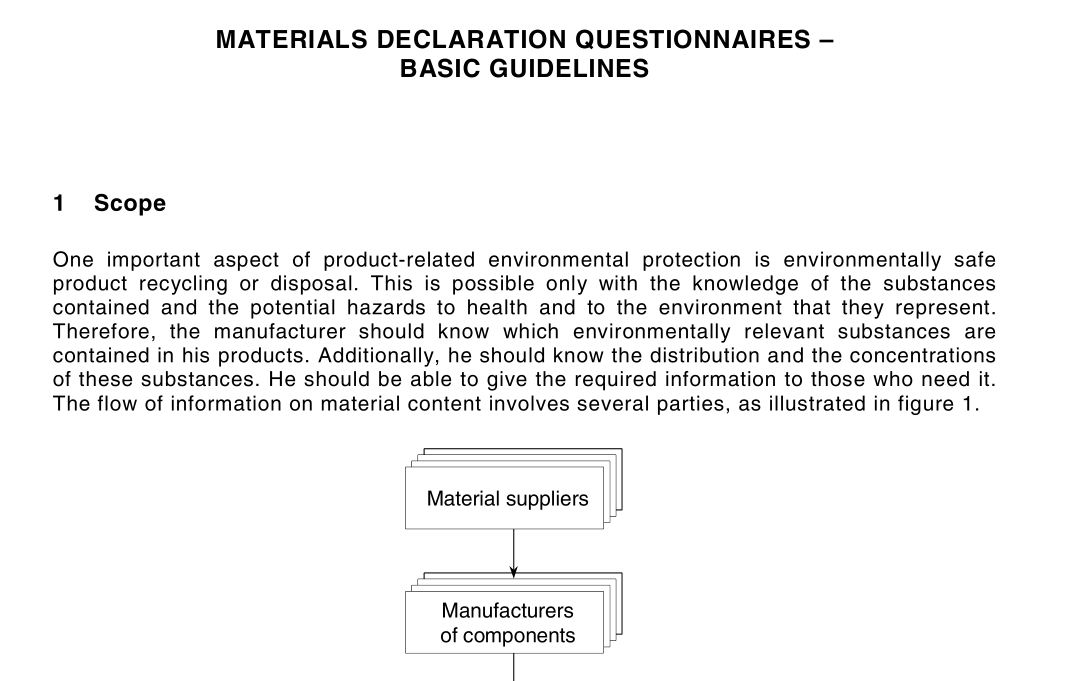IEC Guide 113 pdf download

IEC Guide 113 pdf download.MATERIALS DECLARATION QUESTIONNAIRES – BASIC GUIDELINES
1 Scope
One important aspect of product-related environmental protection is environmentally safe product recycling or disposal. This is possible only with the knowledge of the substances contained and the potential hazards to health and to the environment that they represent. Therefore, the manufacturer should know which environmentally relevant substances are contained in his products. Additionally, he should know the distribution and the concentrations of these substances. He should be able to give the required information to those who need it. The flow of information on material content involves several parties, as illustrated in figure 1 .
This guideline is not prescriptive. It is rather written to assist companies which have to develop materials declaration questionnaires for products, for instance as part of purchase specifications. It intends to increase the harmonization and the comparability of the various questionnaires. This is supposed to lead to cost reduction, both for those sending questionnaires and for those answering them, but it must be kept in mind that the possibilities for harmonizing the materials declaration questionnaires are limited because of the differing needs of those requiring information, and because of the continual changes of the hazardous materials lists.
3 Procedure for developing materials declaration questionnaires
Depending on the product, requirements, level of confidentiality, etc., materials declaration can take different forms, to be agreed between the parties involved. However, some basic points are common to all materials declarations and taking them into account will help to establish a sufficient level of uniformity, thus simplifying work and reducing costs. A materials declaration always involves at least two parties, generally the purchaser (party demanding information) and the supplier (party supplying information). Later, other parties may make use of the original materials declaration, such as refurbishing companies, recyclers, exporters of second-hand equipment, etc. These third parties become in due course the party requiring information. A number of questions should be settled between the purchaser and the supplier before a materials declaration can be defined. The most important ones are: a) Which item (full product, component, part, sub-assembly, etc.) should be considered? Or should a declaration “tree” be used: finished product and components considered separately? If so, which level of detail is required? b) Which criteria should be used to define substances to be declared? c) Above which mass thresholds and/or concentrations should substances be declared? d) Which units for quantities should be used? These points should be settled by consensus between the purchaser and the supplier, preferably based on consensus between all actors in the supply chain. There are cases, however, when the purchaser may prescribe the substances to be declared and/or the mass thresholds or concentrations, without previous discussion. This is the case when regulatory reasons are behind the request for information. In other cases, the choice of substances could be left to the supplier, such as when the purchaser only states the lists of restricted substances or the criteria. In all cases, prior to elaborating any materials declaration.
4 Principles of materials declaration questionnaires
a) Materials declaration questionnaires should respond to the particular product or product group (excluding packaging). b) Materials declaration questionnaires should ask about the specific place or component in which a declared substance is situated. c) Materials declaration questionnaires ask for substances which are intentionally utilized in products and should not ask for substances and residues of substances used in manufacturing processes. d) Substances to be declared should be unambiguously identifiable by nomenclature, preferably by the Chemical Abstracts Service (CAS) registry number or other internationally used registry numbers. NOTE 1 CAS registry numbers are given to chemical compounds. Since a chemical compound can have different names, the CAS registry number is used for unambiguous identification. e) Weight limits above which components or parts of products are taken into consideration should be defined. NOTE 2 Decisive factors can be the risks given by the contained substances and the end-of-life treatment. For example, it can be necessary to declare small switches containing mercury because they can lead to the contamination of shredded material. On the other hand, it may be acceptable to leave out minor flame-retarded plastic parts if the whole product will be incinerated.









